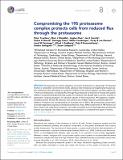| dc.contributor.author | Tsvetkov, Peter | |
| dc.contributor.author | Zhao, Jinghui | |
| dc.contributor.author | Cikes, Domagoj | |
| dc.contributor.author | Varadarajan, Malini | |
| dc.contributor.author | Santagata, Sandro | |
| dc.contributor.author | Lindquist, Susan | |
| dc.contributor.author | Mendillo, Marc L. | |
| dc.contributor.author | Carette, Jan E. | |
| dc.contributor.author | Merrill, Parker H. | |
| dc.contributor.author | van Diemen, Ferdy R. | |
| dc.contributor.author | Penninger, Josef M. | |
| dc.contributor.author | Goldberg, Alfred L. | |
| dc.contributor.author | Brummelkamp, Thijn R. | |
| dc.date.accessioned | 2015-11-02T20:08:54Z | |
| dc.date.available | 2015-11-02T20:08:54Z | |
| dc.date.issued | 2015-09 | |
| dc.date.submitted | 2015-05 | |
| dc.identifier.issn | 2050-084X | |
| dc.identifier.uri | http://hdl.handle.net/1721.1/99666 | |
| dc.description.abstract | Proteasomes are central regulators of protein homeostasis in eukaryotes. Proteasome function is vulnerable to environmental insults, cellular protein imbalance and targeted pharmaceuticals. Yet, mechanisms that cells deploy to counteract inhibition of this central regulator are little understood. To find such mechanisms, we reduced flux through the proteasome to the point of toxicity with specific inhibitors and performed genome-wide screens for mutations that allowed cells to survive. Counter to expectation, reducing expression of individual subunits of the proteasome's 19S regulatory complex increased survival. Strong 19S reduction was cytotoxic but modest reduction protected cells from inhibitors. Protection was accompanied by an increased ratio of 20S to 26S proteasomes, preservation of protein degradation capacity and reduced proteotoxic stress. While compromise of 19S function can have a fitness cost under basal conditions, it provided a powerful survival advantage when proteasome function was impaired. This means of rebalancing proteostasis is conserved from yeast to humans. | en_US |
| dc.language.iso | en_US | |
| dc.publisher | eLife Sciences Publications, Ltd. | en_US |
| dc.relation.isversionof | http://dx.doi.org/10.7554/eLife.08467 | en_US |
| dc.rights | Creative Commons Attribution | en_US |
| dc.rights.uri | http://creativecommons.org/licenses/by/4.0/ | en_US |
| dc.source | eLife Sciences Publications, Ltd. | en_US |
| dc.title | Compromising the 19S proteasome complex protects cells from reduced flux through the proteasome | en_US |
| dc.type | Article | en_US |
| dc.identifier.citation | Tsvetkov, Peter, Marc L Mendillo, Jinghui Zhao, Jan E Carette, Parker H Merrill, Domagoj Cikes, Malini Varadarajan, et al. “Compromising the 19S Proteasome Complex Protects Cells from Reduced Flux through the Proteasome.” eLife 4 (September 1, 2015). | en_US |
| dc.contributor.department | Massachusetts Institute of Technology. Department of Biology | en_US |
| dc.contributor.department | Whitehead Institute for Biomedical Research | en_US |
| dc.contributor.mitauthor | Lindquist, Susan | en_US |
| dc.contributor.mitauthor | Mendillo, Marc L. | en_US |
| dc.relation.journal | eLife | en_US |
| dc.eprint.version | Final published version | en_US |
| dc.type.uri | http://purl.org/eprint/type/JournalArticle | en_US |
| eprint.status | http://purl.org/eprint/status/PeerReviewed | en_US |
| dspace.orderedauthors | Tsvetkov, Peter; Mendillo, Marc L; Zhao, Jinghui; Carette, Jan E; Merrill, Parker H; Cikes, Domagoj; Varadarajan, Malini; van Diemen, Ferdy R; Penninger, Josef M; Goldberg, Alfred L; Brummelkamp, Thijn R; Santagata, Sandro; Lindquist, Susan | en_US |
| dc.identifier.orcid | https://orcid.org/0000-0003-1307-882X | |
| mit.license | PUBLISHER_CC | en_US |
| mit.metadata.status | Complete | |
